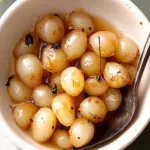Salt and Pepper Squid is a quick, flavorful seafood favorite that’s perfect for those who crave something both crispy and tender. Lightly battered squid rings are deep-fried until they reach a beautiful golden crunch, then quickly tossed with aromatic scallions, vibrant red chilies, and a simple yet bold seasoning of salt and white pepper. The result is a dish that delivers on texture, spice, and satisfaction—all in under 30 minutes. Whether you’re planning a casual dinner, a snack for friends, or an easy back-to-college meal, this recipe is ideal for busy schedules and tight budgets without compromising on taste.
Full Recipe:
Ingredients
-
10 oz squid tubes, cleaned and sliced into rings
-
Oil for deep-frying
-
½ tbsp oil (for stir-frying)
-
2 tbsp chopped scallions
-
1 tsp chopped red chilies
-
½ tsp salt (adjust to taste)
-
½ tsp ground white pepper
For the frying batter:
-
½ cup all-purpose flour
-
½ cup corn starch
-
½ tsp baking soda
-
1 egg white
-
½ cup water
-
A pinch of salt
Directions
-
Rinse the squid thoroughly and pat it completely dry, ensuring no excess moisture remains. Coat evenly with the prepared batter.
-
Heat oil in a wok or deep frying pan to approximately 175 °C (350 °F). Fry squid rings until golden brown and crispy, taking care not to overcook. Remove and drain on paper towels.
-
In a separate skillet, heat a small amount of oil and stir-fry the scallions and chopped chilies until fragrant.
-
Return the fried squid to the skillet, sprinkle with salt and white pepper, and toss quickly to combine. Serve immediately while hot and crispy.
Nutrients
Nutrition per serving (based on 3 servings):
-
Calories: 273 kcal
-
Carbohydrates: 39 g
-
Protein: 18 g
-
Fat: 4 g
-
Saturated Fat: 1 g
-
Polyunsaturated Fat: 1 g
-
Monounsaturated Fat: 2 g
-
Trans Fat: 0.01 g
-
Cholesterol: 220 mg
-
Sodium: 633 mg
-
Potassium: 288 mg
-
Fiber: 1 g
-
Sugar: 0.3 g
-
Vitamin A: 87 IU
-
Vitamin C: 8 mg
-
Calcium: 40 mg
-
Iron: 2 mg
Why This Recipe Stands Out
What makes this Salt and Pepper Squid so memorable is the way it perfectly balances crunchy coating with tender seafood. Each bite delivers a satisfying crackle, followed by the gentle chewiness of squid that has been cooked just right. The addition of scallions and red chilies adds a burst of color and a subtle yet noticeable heat, making it much more exciting than plain fried squid. Best of all, the ingredient list is short, and the cooking time is minimal—ideal for college students who want something fresh, flavorful, and filling without spending hours in the kitchen.
It’s also incredibly versatile. You can serve it as a snack during late-night study sessions, as part of a casual dinner spread with friends, or even pack it for a lunch that will make your campus meal prep stand out. The recipe’s simplicity doesn’t mean sacrificing taste; instead, it focuses on letting the natural sweetness of squid shine through while adding layers of flavor through seasoning and aromatics.
The Benefits of the Ingredients
Squid is a powerhouse ingredient for students and busy professionals alike. It’s naturally low in fat yet high in protein, making it great for fueling your brain and body during long days of classes or work. It also contains key nutrients like vitamin B₁₂, which supports focus and energy, and selenium, which helps maintain a healthy immune system.
The batter—made from a blend of all-purpose flour, corn starch, and baking soda—creates a light, airy crust that’s both crunchy and less greasy than many fried foods. Corn starch is particularly useful here, as it keeps the coating crisp even after the squid is tossed with seasonings. Egg white binds everything together while contributing to the batter’s delicate texture.
Scallions and chilies not only enhance the flavor but also pack in antioxidants, vitamins A and C, and compounds that support overall health. White pepper offers a slightly different heat profile than black pepper—more earthy and less sharp—which complements seafood beautifully without overpowering it. Together, these ingredients create a dish that feels indulgent while still delivering nutritional value.
Cooking Tips
Success with this recipe comes down to a few key steps. First, drying the squid thoroughly is crucial. Moisture prevents the batter from sticking well, and excess water can cause oil to splatter dangerously. Use paper towels to pat the squid completely dry before coating.
Maintaining the oil temperature is another essential step. Aim for 175 °C (350 °F) and check it with a thermometer if possible. If the oil is too cool, the batter will absorb more oil, resulting in a heavy texture; too hot, and the squid will toughen. Frying in small batches ensures the oil temperature stays stable and the squid cooks evenly.
When stir-frying, high heat is your friend. The aromatics—scallions and chilies—should be sizzling and fragrant before you add the fried squid back in. This quick toss keeps the squid from overcooking and losing its tender bite. After frying, let the squid rest briefly on paper towels to wick away excess oil. If you need to prepare it ahead of time, reheat it quickly in an oven or air fryer to restore crispness before serving.
Serving Suggestions
This dish is at its best when enjoyed right after cooking, while the squid is still hot and the coating is ultra-crispy. As an appetizer, it pairs well with dipping sauces like sweet chili, garlic aioli, or even a tangy lemon mayo. You can also serve it with lime wedges for a fresh citrusy brightness that cuts through the richness.
For a more substantial meal, serve over steamed jasmine rice or alongside vegetable fried rice for a satisfying balance. It also works wonderfully as part of a multi-dish spread—think dumplings, stir-fried greens, or even a spicy noodle dish for variety.
If you’re a college student looking for lunchbox ideas, this can be packed with a small salad, pickled vegetables, and a dipping sauce in a separate container to maintain crispness. Just keep in mind that fried foods are always best fresh, so if packing ahead, plan to reheat briefly before eating.
For parties or game nights, serve in small paper cones or bowls for easy snacking. The bold flavors and crunchy texture make it a crowd-pleaser that requires minimal last-minute effort.
Conclusion
Salt and Pepper Squid is a recipe that proves you don’t need an extensive ingredient list or hours in the kitchen to create something special. Its combination of crispy texture, tender seafood, and bold seasoning makes it irresistible, while its quick cooking time makes it perfect for busy days. For students returning to campus, it’s a fantastic addition to your back-to-school recipe rotation—fast enough to whip up between classes and flavorful enough to keep you looking forward to mealtime.
It’s affordable, adaptable, and delivers restaurant-quality results at home. Whether you’re making it for yourself, sharing it with roommates, or serving it as part of a weekend dinner, this dish fits seamlessly into a busy lifestyle without sacrificing flavor or satisfaction. Add it to your recipe collection, and you’ll have a go-to favorite that’s as fun to cook as it is to eat.






